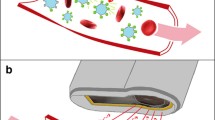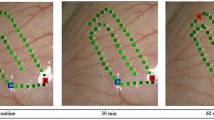Abstract
Spatial alterations in blood flow during the development of mucosal injury induced by ischemia-reperfusion in rats were determined with a two-dimensional laser Doppler tissue perfusion imager. The rats were anesthetized with pentobarbital, and the stomach was exteriorized on a stage; the mucosa was then sequentially scanned. The mucosa was constantly superfused with 0.1N HCl in physiological saline. Systemic arterial pressure was continuously monitored and blood was stepwisely withdrawn from the femoral artery by 20-mmHg stage and then maintained at 20 mmHg for 20 min. The shed blood was reinfused and the stomach was removed 30 min later. Under control conditions, the average perfusion of the forestomach was usually greater than that in the glandular stomach. When systemic blood pressure was stepwisely decreased, the extent of decrease in the mucosal blood perfusion unit was always greater than that in systemic blood pressure, but mucosal perfusion appeared to be uniformly decreased throughout the stomach. Ten min after reperfusion, a hypoperfused area began to appear in the corpus near the greater curvature, and this area subsequently increased. The area of ulcer formation corresponded with the hypoperfused area in the gastric mucosa 30 min after reperfusion. Pretreatment with CV-6209, a platelet-activating factor antagonist, significantly attenuated the hypoperfusion induced by reperfusion and also prevented gastric mucosal damage. Our results suggest that hypoperfusion in the mucosal microcirculation is indeed an important factor contributing to the localized occurrence of gastric mucosal lesions and that the laser Doppler perfusion imager is useful for the detection of local hypoperfused areas in the gastric mucosa.
Similar content being viewed by others
References
Soll AH. Gastric, duodenal, and stress ulcer. In: Sleisenger MH, Fordran JS (eds) Gastrointestinal disease. Pathophysiology/diagnosis/management. vol. 1. Philadelphia: WB Saunders, 1993;580–679.
Morishita T, Guth PH. Effect of exogenous acid on the rat gastric mucosal microcirculation in hemorrhagic shock. Gastroenterology 1987;92:1958–1964.
Kamada T, Sato N, Kawano S, et al. Gastric mucosal hemodynamics after thermal or head injury—a clinical application of reflectance spectrophotometry. Gastroenterology 1982;83: 535–540.
Leung FW, Itoh M, Hirabayashi K, et al. Role of blood flow in gastric and duodenal mucosal injury in the rat. Gastroenterology 1985;88:281–289.
Nagata H, Morishita T, Minamitani H, et al. Relation between localization of gastric mucosal lesions and microvascular disturbance (in Japanese with English abstract). Nippon Shokakibyo Gakkai Zasshi (Jpn J Gastroenterol) 1990;87:1357–1363.
Kurose I, Fukumura D, Miura S, et al. Fluorographic study on the oxidative stress in the process of gastric mucosal injury: Attenuating effect of vitamin E. J Gastroenterol Hepatol 1993; 8:254–258.
Kurose I, Suematsu M, Miura S, et al. Involvement of superoxide anion and platelet-activating factor in increased tissue-type plasminogen activator during rat gastric microvascular damage. Thromb Res 1991;62:241–248.
Terashita Z, Imura Y, Takatani M, et al. CV6209, a highly potent antagonist of platelet-activating factor in vitro and in vivo. J Pharmacol Exp Ther 1986;242:263–268.
Kurose I, Miura S, Fukumura D, et al. Role of plateletactivating factor in the fibrinolytic activation in the pathogenesis of gastric mucosal damage induced by endothelin-1. Gut 1992; 33:868–871.
Troilius A, Wårdell K, Bornmyr S, et al. Evaluation of port wine stain perfusion by laser Doppler imaging and thermography before and after argon laser treatment. Acta Derm Venereol 1992;72:6–10.
Wårdell K, Naver HK, Nilsson GE, et al. The cutaneous vascular axon reflex characterized by laser Doppler perfusion imaging. J Physiol 1993;460:185–199.
Nilsson GE, Jakobsson AJ, Wårdell K. Monitoring and imaging of tissue blood flow by coherent light scattering. In: Prastesi R (ed) Optronic techniques in diagnostic and therapeutic medicine. New York: Plenum, 1991;89–99.
Menguy T, Masters YF. Mechanism of stress ulcer. II. Difference between the antrum, corpus and the fundus with respect to the effect of complete ischemia on gastric mucosal energy metabolism. Gastroenterology 1974;66:509–516.
Shiraji S, Mueller TM, Hardy BM. Canine gastric acid secretion and blood flow measurement in hemorrhagic shock. Gastroenterology 1977;73:75–78.
Kivilaaksi E, Fromm D, Silen W. Relationship between ulceration and intraluminal pH of gastric mucosa during hemorrhagic shock. Surgery 1978;84:70–77.
Itoh M, Guth PH. Role of oxygen-derived free radicals in hemorrhagic shock-induced gastric lesions in the rat. Gastroenterology 1985;88:1162–1167.
Granger DN, Hollwarth ME, Parks DA. Ischemia-reperfusion injury: Role of oxygen-derived free radicals. Acta Physiol Scand [Suppl] 1986;548:47–63.
Kubes P, Ibbotson G, Russell J, Wallace JL, Granger DN. Role of platelet-activating factor in ischemia/reperfusion-induced leukocyte adherence. Am J Physiol 1990;259 (Gastrointest Liver Physiol):G300-G305.
Zimmerman BJ, Guillory DJ, Grisham MB, Gaginella TS, Granger DN. Role of leukotriene B4 in granulocyte infiltration into the postischemic feline intestine. Gastroenterology 1990; 99:1358–1363.
Zimmerman BJ, Granger DN. Reperfusion injury. Surg Clin North Am 1992;72:65–83.
Suzuki M, Grisham MB, Granger DN. Leukocyte-endothelial cell adhesive interactions: Role of xanthine oxidase-derived oxidants. J Leuko Biol 1991;50:488–494.
Wallace JL, Whittle BJR. Picomole doses of platelet-activating factor predispose the gastric mucosa to damage by topical irritants. Prostaglandins 1986;31:989–998.
Sugatani J, Fujimura K, Miwa M et al. Occurrence of platelet-activating factor (PAF) in normal rat stomach and alteration of PAF level by water immersion stress. FASEB J 1989;3:65–70.
Suematsu M, Kurose I, Asako H, et al. In vivo visualization of oxyradical-dependent photoemission during endotheliumgranulocyte interaction in microvascular beds treated with platelet-actvating factor. J Biochem 1989;106:355–360.
Author information
Authors and Affiliations
Rights and permissions
About this article
Cite this article
Miura, S., Fukumura, D., Kurose, I. et al. Spatial heterogeneity of mucosal blood flow during ischemia-reperfusion injury of rat stomach investigated by laser Doppler perfusion imaging. J Gastroenterol 30, 279–286 (1995). https://doi.org/10.1007/BF02347500
Received:
Accepted:
Issue Date:
DOI: https://doi.org/10.1007/BF02347500




